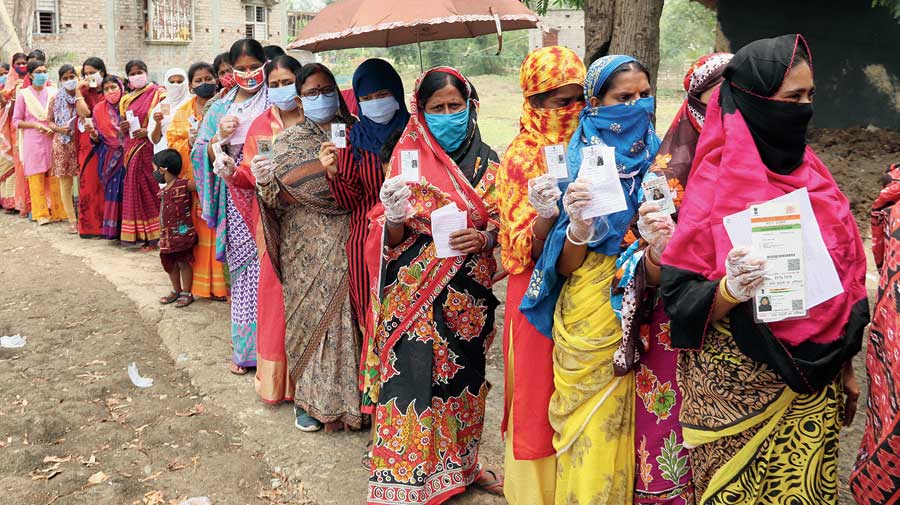The resounding victory of the Trinamul Congress in the assembly elections can be attributed to the overwhelming support of women voters across social and economic groups. Unlike many states, West Bengal has a unique history of women exercising their suffrage. The Left had mobilized women through different mass movements, giving a huge impetus to women’s participation in elections — in the early 1980s it touched almost 70 per cent. Given the high turnout of women voters, they had a pivotal role in electoral outcomes. Several post-poll surveys in the last decade show that there has been a steady increase in women supporters of the TMC since it assumed power in 2011.
The ascendancy of Mamata Banerjee as the chief minister has kindled the aspiration of women in politics. Banerjee has also consistently created space for women lawmakers — in the current assembly about 15.5 per cent of the members from the TMC are women, a remarkable achievement compared to other parties in the assembly.
Even amidst anti-incumbency sentiments, charges of corruption at the local level and high-pitched polarization, Banerjee emerged as the preferred chief minister in several rounds of pre-poll and post-poll surveys. Across social groups, women have largely rallied behind Banerjee; ethnographic studies indicate that Didi enjoyed more support among Muslim women compared to their male partners.
Many commentators have highlighted that Banerjee’s welfare programmes contributed to the expansion of her support base among women. Welfare programmes like the Kanyashree Prakalpa, Sabooj Sathi, and various educational incentives for scheduled castes, scheduled tribes and minorities yielded huge dividends. Contrary to the national trend, the educational statistics indicate that girls in West Bengal have outnumbered boys in the secondary level, significantly reducing the gender gap in education. The Kanyashree Prakalpa, ensuring a yearly stipend of Rs 750 and Rs 25,000 upon the attainment of 18 years while remaining unmarried, has received international accolades.
As a course-correction measure Kanyashree was repurposed as a universal programme, cutting across social groups and economic classes. This has had multiple implications; the sheer number of beneficiaries has increased manifold in the past few years, touching over 70 lakhs. Similarly, although the Sabooj Sathi — providing bicycles to secondary students — facilitated school enrolment, a study by the Pratichi Institute confirms that girls have benefited more than boys. Besides reducing the transport cost, Sabooj Sathi saves girls from everyday harassment in public transport, and ensures a sense of empowerment. A sizeable section of students from recognized madrasas also benefited from the project. The initial cohorts of these flagship programmes are now first-time voters; many of them may have voted for the TMC, showing their gratitude to Didi.
In 2019, the TMC suffered a jolt as the Bharatiya Janata Party won 18 seats in the general elections and grievances against welfare schemes mounted. The TMC turned the crisis into an opportunity — a political programme, ‘Didi ke Bolo’, along with the public grievance redressal cell set up in 2019, under the aegis of the chief minister’s office, provided a platform to air these grievances.
Over a short span of one and a half years, the cell appears to have dealt with more than 10 lakh grievances with an impressive record of 95 per cent resolution rate. It is encouraging to note that participation of women in airing their grievances is almost 45 per cent although most households are headed by men.
A large proportion of women responded and reacted to a plethora of schemes specially designed for them, including the Rupashree Prakalpa and educational scholarships for specific social groups and widow pension schemes. Speedy redressal of grievances helped girls attain education and other core capabilities. The overwhelming participation of women in ‘Duare Sarkar’ — a direct outreach programme to ensure prompt grievance redressal and service delivered at the doorstep of beneficiaries — revealed the faith in the incumbent. The masterstroke was the extension of Swasthya Sathi — a health insurance of Rs 5 lakh, issued in the name of women heads of households, which touched lakhs of beneficiaries.
On the contrary, the campaign of the BJP was replete with communal venom and considerable misogynistic statements, largely ruining its political ambition in West Bengal. The BJP strived to win this election based on religious polarization, completely overlooking the sound support base of the TMC among women. The voting pattern of women has tilted the results in favour of the TMC.











